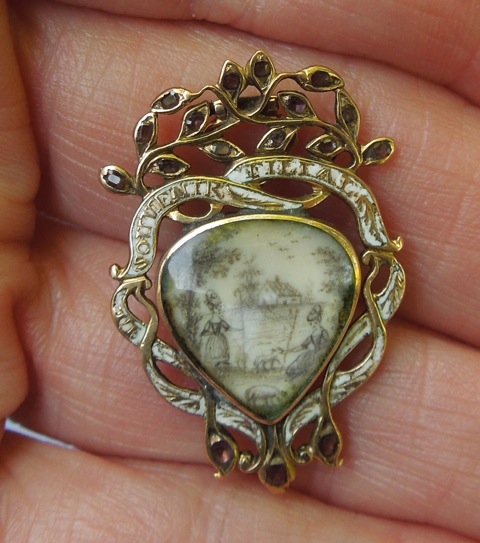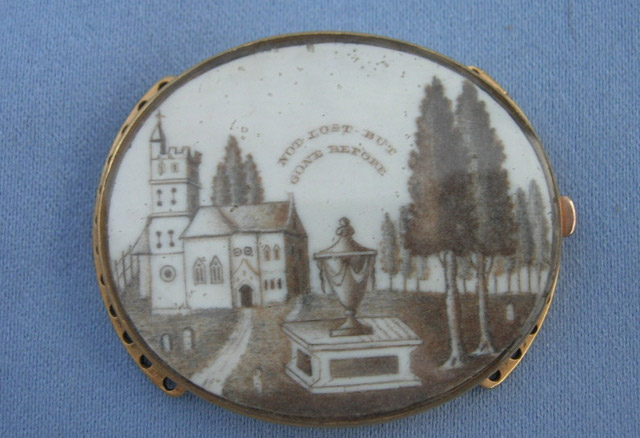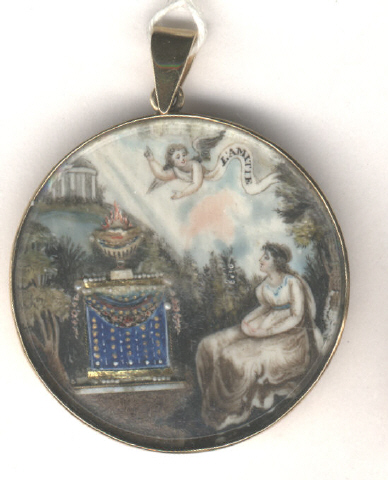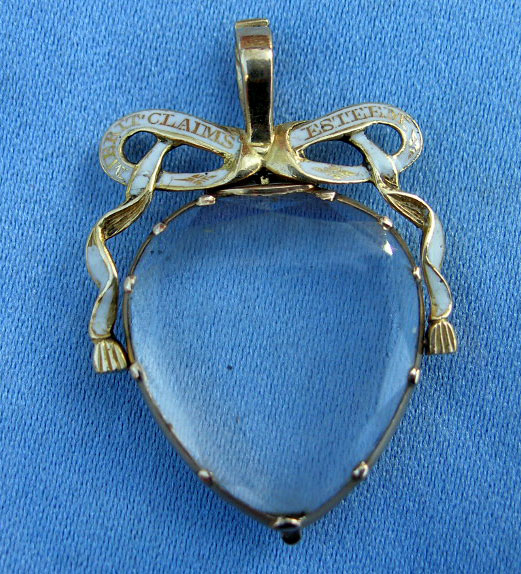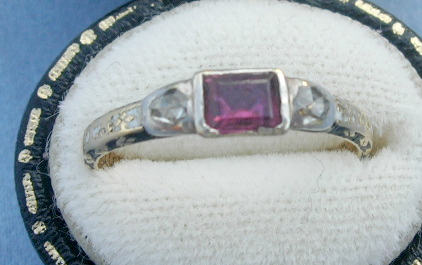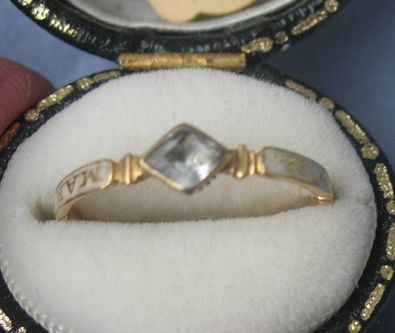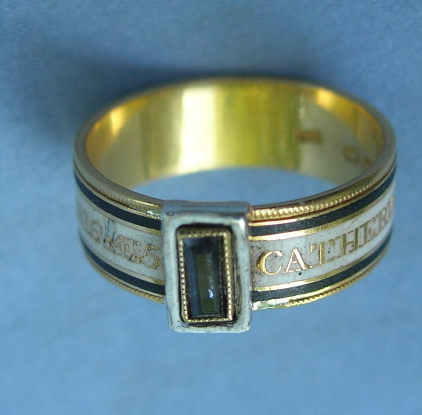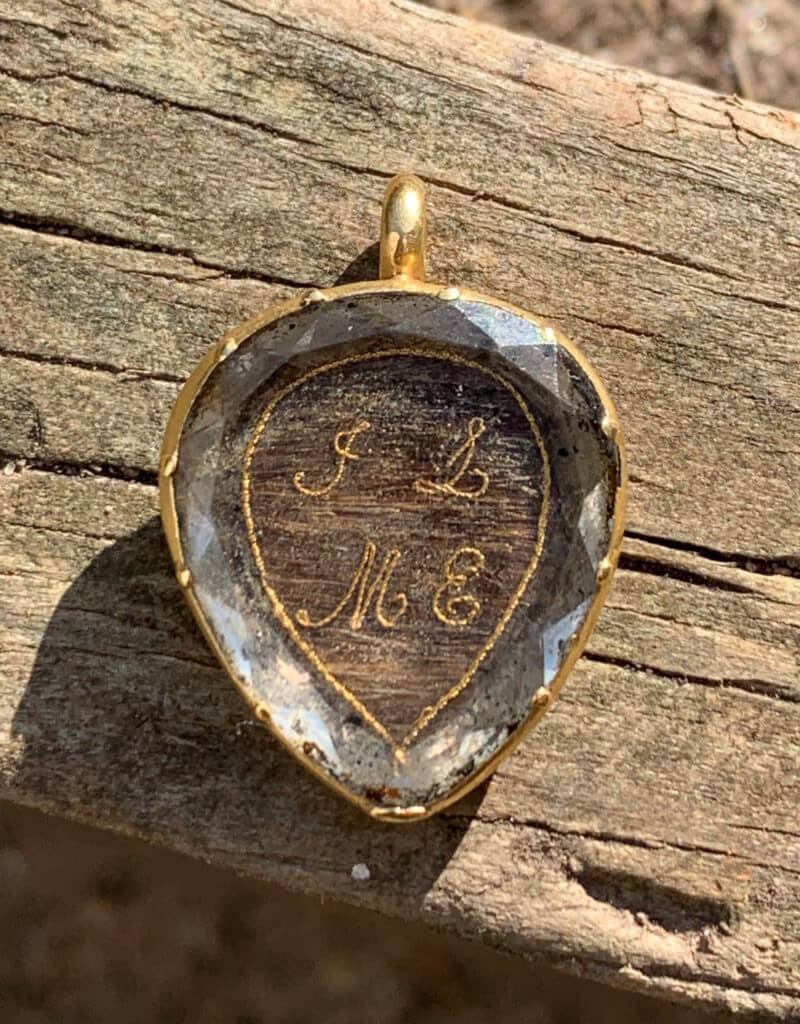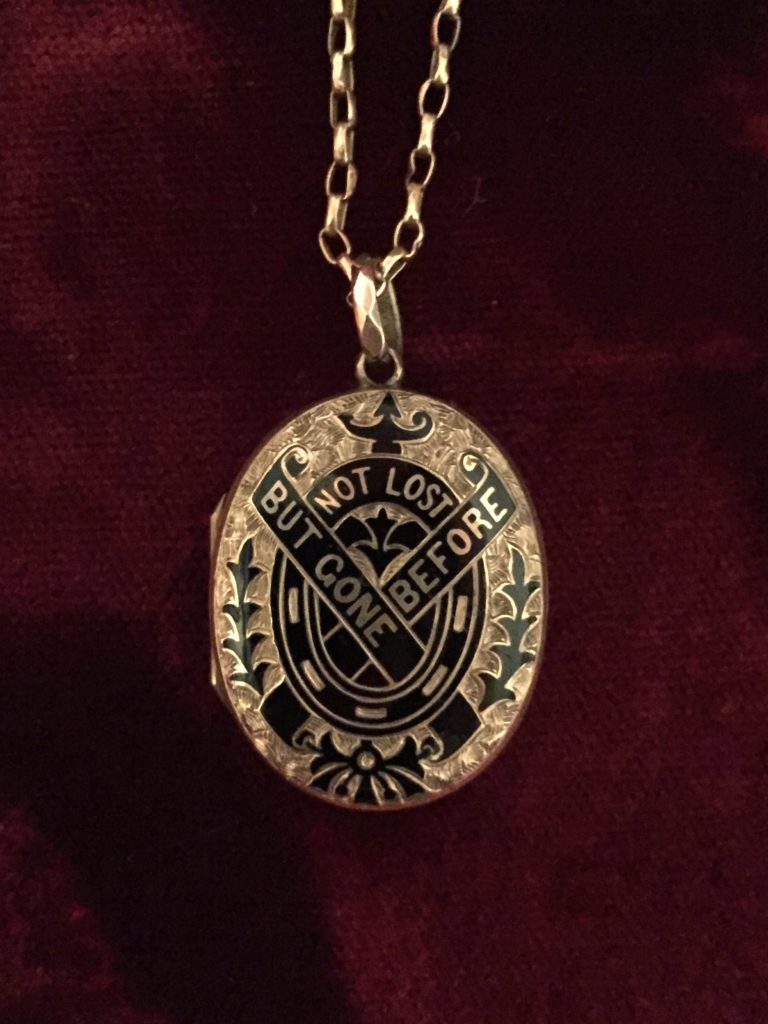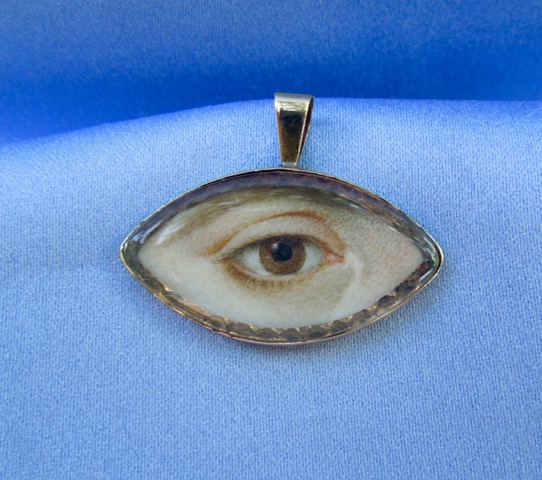“Souvenir Filial” Sepia Heart Pendant
Appreciating every element of a jewel brings together a narrative of history that relate to a certain period’s style and sensibilities towards love and affection. Encapsulating the first glance at a jewel like this resonates with a modern audience, as it would have when it was first made. The heart, showing the element of love for another, the ornate beauty of the lush Rococo period and the scenario of the shepherdesses, sheep, birds and homestead, narrow the focus of the jewel to a very loving sentiment.
The further we look into the pendant, the more we see the style of the time, with the costume of the ladies reflecting popular French influenced fashion of the late 18th century, from the high post-1770s powdered look, to the low necked, open front gown (showing petticoat underneath) and three-quarter sleeves are displayed by the two ladies.
More telling is the sentiment itself. ‘Le Souvenir Filial’ refers to duty and affection, which, in the most broad sense of mourning and sentimental jewels, the aspect of piety and fidelity for another is the true core of their values. A token of love for a person who has departed, be it a physical departure of distance or one of mortality, it doesn’t matter – the value of not being with someone is the sole reason that a jewel like this was worn.
On the reverse is the empty material where hair would have been placed. Many sentimental jewels held compartments for hair to be placed or hairworked, yet many are lost to time due to many reasons (not simply the disintegration of the hair, but the re-appropriation of the jewel). For many antique dealers, it is easier to take away the hair for resale value, as the practice of hairwork is considered morbid by many modern audiences, hence the loss of the hair is unfortunate and at many times arbitrary.
Georgian Heart
The heart is the most important element of focus in this pendant, as it is the first identifier for what the jewel represents for the wearer. Being seen from a distance when worn at the neck means that this pendant was clearly a statement of love and affection, which relates back to the relationship status of the wearer. When the heart was worn for a loved one who was alive, it was a symbol of betrothal, marriage or love and affection, or if dead, grief for the departed. With the rise of cupid in sentimental jewels, the heart was a popular motif from the 17th to 19th century, but one which obviously resonates just as strongly today, as the production of heart-shaped pendants and lockets is still a popular design in jewellery.
The heart has its origins in jewellery from the 15th century, but was enhanced in the 17th through the Enlightenment and the reflections of the humanist movement, but could also be appropriated for religious undertones when necessary.
It is important to note that the heart shape which we understand today is still reflected in these jewels with the broad element of the shape. Upon viewing, the north of the pendant doesn’t have the sharp dovetail into the centre of the pendant, but rather curves around itself. The familiar shape is seen at the south of the pendant, with the edges coming to the familiar shape of the heart that we recognise today. Elements of the heart shape had been perfected by the early 17th century, but the adaptation of the shape was common for sentimental jewels through the 18th and early 19th century, due to many other factors of the design flanking the shape and adding to its form.
In this piece, we can see it through the use of the Rococo ribbon motif, which we shall discuss later.
As written about extensively at Art of Mourning, the heart is one of the most important sentimental love symbols in early-modern history. Its obvious symbolism resonates today in tokens of love and affection, moving beyond religious and social values to be the most purely recognised understanding of love. With an anthropomorphic design, the heart symbol became popular in the 17th century with its romantic undertones of giving ‘your’ heart to another. For more on the development of this symbol, please consult “Embellished Georgian Heart Love Pendant” and the following articles:
> Georgian Heart with Hairwork Twist in Crystal, 1824
> Three-Dimensional Urn Locket, Garnets, Pearls and Ribbon!
> Georgian Eye Miniature Inside a Pendant, c.1820
> Late Georgian Heart Pendant With Hairwork
> Rien Sans Amitie, Cabochon Garnet French Mourning Locket
> Merit Claims Esteem/Bow Heart Locket, 18th Century
> French Ribbon Pendant, 18th Century
> 18th Century Ribbon Motif Pendant
> An Eternity Knot in a Crystal Heart Pendant
> Mourning Crystal “Georgian” Heart
> Stuart Crystal Heart Pendant with Angels and Crown
> Memento Mori Stuart Crystal Heart
> Diamond Navette Ring, Late 18th Century
> 18th Century Diamond Fede Ring
> Late Georgian Heart Pearl Pendant 19th Century
> The Hon Alice Nugent in a 1730 Mourning Locket and the Hairwork Eternity
> Is It, Or Isn’t It? Heart Pendant – First Impressions
Sheep, Shepherdess and Sentimental Depiction
Painted in sepia tones, the depiction of the homestead, sheep, shepherdesses and trees are in continuous motion. The wind, as it strikes from the top left is drawing a flock of birds away, towards the home. In the foreground, we have the two ladies, wearing fashionable garments and both holding crooks.
One sheep is in the direct foreground, framing the absolute south of the piece, while another is nestling to the lady on the right. Both ladies are wearing straw hats, which was fashionable in the 1780s, influenced by none other than Marie Antoinette. Notice the proximity between the two ladies in the scene, with the lady on the left viewing the sheep and the lady on the right. There is an element of distance between the two, but the familiarity of being joined through their own flock. This is the familial connection within sentimentality.
The homestead within the horizon is a telling sight, recalling much of the classical connection to a temple in some Neoclassical depictions, but being more literal in its way. This shows that the piece was painted as a bespoke sentiment by an artist, or at least that the artist was individual enough to tailor his own style around a request.
Let us take into account that the sheep/lamb is an animal of ancient origin. Lamb has been fundamentally important to the growth of civilisation, having its roots c.8000 BCE in a southern Anatolian area named Çatalhöyük. The sheep has been recorded in Cuneiform by the Sumerians for the purpose of gods/goddesses who represent/protect flocks and not only were they worshipped, but they were essential to the socio-economic growth of society.
So, as far back as animal worship is considered, sheep are part of the mainstream lexicon. These are animals which produced clothing, meat, milk and fertilisation of the land. The Egyptians depicted the god Khnum with the head of a ram, at the temples at Elephantine and Esna; one of the earliest deities, known as the Nile River’s source. This, in effect, shows just how fundamentally important the lamb was to society.
Lambs were also used in sacrifice towards deities in ancient cultures. The Greeks and Romans practiced animal sacrifice towards deities and it is from this that the concept of sacrifice carries on through the mainstream mind and transcends eras of culture. However, while there were connections of the lamb to deities themselves, it wasn’t for this that we see the symbol commonly used in jewellery from the 18th century.
As the symbol was re-appropriated for the Neoclassical era, that doesn’t have the direct connection to the resonance of the symbol that we’re necessarily looking for. What we need to consider are the Judeo-Christian values of the symbol, which resonate through the society that created this Neoclassical revival.
The Paschal Lamb (Korban Pesach/”sacrifice of Passover”) represents the blood sacrifice put upon door posts of the Israelites to deflect the angel of death from killing the first born of Egypt. It is from here that we have to focus upon the lamb as a sacrifice and how it relates to Jesus. The following passage from from Leviticus 4:32-34:
32‘But if he brings a lamb as his offering for a sin offering, he shall bring it, a female without defect.
33He shall lay his hand on the head of the sin offering and slay it for a sin offering in the place where they slay the burnt offering.
34‘The priest is to take some of the blood of the sin offering with his finger and put it on the horns of the altar of burnt offering, and all the rest of its blood he shall pour out at the base of the altar.
Here, we have a direct reference to the sacrifice of the lamb to atone for sins. The lamb is the symbol of purity and innocence; its sacrifice restores the balance of sin. This relates to the Angus Dei, as John (1:29) had stated;
29 The next day John saw Jesus coming toward him and said, “Look, the Lamb of God, who takes away the sin of the world!
God’s son on earth to take away the sin of the world. The dichotomy here is that the sacrificial lamb from the Old Testament was sacrificed for the sins of others, whereas Jesus knowingly became the sacrificial offering for the world.
Adversely, we have Jesus as the ‘Good Shepherd’, another link to the jewellery that we’ll be looking at (I promise) soon:
11 “I am the good shepherd. The good shepherd lays down his life for the sheep. – John 10:11
Now we enter the realm of a universal symbolism for the lamb and the shepherd; the protector and the protected. The nurturer who guards the flock and would willingly provide the sacrifice for their child. When one takes this into account for the jewellery that displays the depiction of the female shepherdess, we have a complete union of symbolism. There is the delineation between the religious context of the lamb/Christ and the lamb for its direct child/innocence context.
In jewelery, there are several instances in memorial and sentimental jewellery where the lamb plays a very visible and direct role in the interpretation of symbolism. Much of these have the same relation to the shepherdess and her flock. This transmutes well through various mainstream styles in fashion, due to its ecclesiastical standpoint and also its depiction of ideallic beauty. If you’ve been reading along with me for long enough, you know that both of these things facilitate the changeover from the 18th to 19th centuries.
However, as popular as this symbol is, it’s been linked in the mainstream mind, reinforced every Sunday at your local Church with Jesus as the ‘good shepherd’ and a motif as primal as Western civilisation itself. Hence, when we consider the implications of this religious undertone and how it can appeal in the Neoclassical era, a time when much of this Christian identity was pushed behind the nature of the self, we are still left with a symbol that isn’t so overt as to make an instant statement about its purpose. It relates both to the person, the event/occasion and the religion to which it belongs.
These are the reasons why the lamb and shepherd (or shepherdess) are so consistent in jewellery depictions. By the Neoclassical era, it’s worthwhile to note that the sentiments of religion were not forgotten, simply not so indoctrinated into daily lifestyle and custom. Hence, when a motif, such as these, are used in a more prominent way to identify the grief or love of a person, then it reinforces the nature of the religious purpose as much as it depicts a beautiful scene.
Note this sepia piece, dating from c.1780-90 and its use of the lambs at the feet of the shepherdess as she holds the crook and writes initials into the tree. Depictions of Jesus in Neoclassical pieces would be considered anachronistic and certainly don’t fit with mainstream fashion and how culture had re-appropriated classical thought. With this piece, we have a woman (as much of the Neoclassical depictions display the shepherd), which becomes an allegory for Christ and also a representation of the self. Something of this nature would not be possible in the previous century. What we’re left with immediately places us in the scene of the female, relating her directly to the wearer or the person who commissioned it.
Then we take into account the lambs at her feet. These animals are nestled over each other, in an act of pure gentility, peace, comfort and love. The shepherdess is carrying the crook as to bring her flock close to her at all times and protect them from harm; the crook itself in other pieces (as seen earlier) can also morph into the very symbol of the cross itself, becoming a crosier. The initials in the tree are another wonderful feature that enhances the lamb symbolism in this piece, as she gently scrawls with a smile on her face the initials that we can assume are those of a child. From this, we have a beautiful sentiment of love and one that would be commissioned for the birth of a child as the pride of the mother.
Moving back into the more literal depiction of the lamb/shepherdess combination, the motifs are used for mourning as much as they are for sentimental purposes in the late 18th century. Due to the aforementioned combination of connotations regarding the symbols, they related to the self, rather than a global concept. Hence, the motifs could be used in mourning of the death of a child or unwed woman. The key to understanding these motifs is that the female represents the mother and this is essential to understand the family dynamic of why they were created. A mother in mourning, displaying this affection and grief outwardly is just as important as showing a tomb depiction with a mourning character displayed. These motifs balance well with the more obvious mourning symbols, such as the weeping willow or other garden motifs, but aren’t as prolific next to a tomb.
Then we can look at how the 19th century interpreted these motifs. There aren’t any essential concepts that take away from the ideal of what they appear to be. If the viewer wants to see the lamb and shepherdess (moving towards just a female) in the piece, then that is their interpretation. It still has the basic religious meaning, and without the female depicted with the crook, it links back to the Christian motifs far stronger. However, it was still acceptable for the female depiction in the Romantic period of the 19th century and from the 1850s, finding this motif painted or in mosaic is not uncommon. It becomes not an immediate method of displaying affection as it does an allegorical one. The scenes are not current with the 19th century, a society increasingly industrialised, but reflecting upon the past, where the shepherd and romantic imagery were further removed from the society that displayed them. They were, in effect, becoming concepts of the ideal, hence their romantic nature.
From this, the idea of the lamb as a child is one of the most universal concepts. It is the symbol of this that is found at the grave of children for its simplicity of purity and innocence. For all the seeming tragedy of a sacrifice, the relation to Christ only enhances the gentleness of the symbol, by identifying with innocence, meekness, humility and gentleness.
Rococo Elements
In the use of the ribbon motif, this piece clearly dates it post 1740, as the Rococo movement had introduced the ribbon design as a popular way of encapsulating a jewel (particularly pendants and lockets). Within this, the sentiment is inscribed, which was also typical of the time between French and British jewels, however this one is more interesting for its use of the garnet vines entwining within the design.
Much of this is due to the creation of the piece, with it’s French origin. The Rococo style was driven by decorative arts movements in Paris, Prague, Lisbon, Vienna and Italy, then popularised by Louis XIV and XV (respectively). Taking the Baroque style and adding a naturalist, overly ornate elegance to embellish it, seeded its way through furniture, architecture, design and art. Here, with this pendant, we can see the separation of a formal, unified pendant style (such as the oval/rectangular shapes of the late 17th and early 18th century), turning the elements into the elaborate ribbon with its white enamel message.
These garnets speak to the element of new life and resurrection of the grape; the grape can also represent Dionysus, but not in a jewel that reflects elements of mourning. It is not uncommon to find the leaf used in Christian churches or funeral funeralia, as they also show the triumph of victory over death and the joys of heaven.
In literal terms, look at the symbol itself and note the behaviour of the grape. It is a plant which grows in abundance and one of the earliest cultivated crops known to mobilised society, hence the connection to the symbol bearing fruit for the harvest. Here is an element of birth/rebirth within the representation of the grapes and also its connection to victory, as the ripe harvest shows the promise of the fruits rewards being reaped and turned into the production of sustenance for the future as well as a product which promotes happiness. In this, there is the link towards Dionysus, with the vine being worn by cult members to represent a god closely connected to wine (also the bull, serpent and ivy) and its intoxicating effects. Interestingly enough, there are parallels between Dionysus and Jesus that stem from the transubstantiation of water/wine and resurrection, but I find that these reinforce the symbol’s intent and its use when worn in jewellery.
The motif can be found in Neoclassical pieces, but much more commonly in the second half 19th century pieces, where it is often embellished in lockets, pendants or manufactured as charms. When used in Neoclassical depictions, the symbol is often a secondary motif, relegated to being a symbol that works in conjunction with its surroundings to enhance symbolic meaning, such as wrapped around a column or plinth, combined with oak, held by the human subject of the depiction or bordering the piece itself.
In the 19th century uses, post 1840 and the re-introduction of Christian family values, the symbol becomes one used prominently and often alone. Much of this usage is directly because of its Christian leaning as a symbol and for the very reason that the symbol conveys a positive message of rebirth/birth.
Rococo is the style that would resonate through to English society and dominate jewellery designs in the 18th century. Since the Restoration period, the influence of European styles and philosophy, facilitated by social change and history discovery would shift the importance of the ‘self’ from the monarchy to the person.
Note the use of garnets and the relation of this setting into these particular rings:
> Embroidered Hair on Silk/Material Ring, 1763
> Eternity Knot Ring Shows Changing Styles in the 18thC
Garnets, particularly, were becoming the popular gem of choice for many memorial and sentimental jewels. Their use, from a symbolic point of view, was to enhance the meaning of the jewel they were set in, which was facilitated by the growing language of gems to relate to their symbolism. As the stages of mourning became indoctrinated, the use of gems for their colours and meaning became more and more important as a personal representation of mourning in fashion.
White Enamel
As can be seen in the Rococo ribbon element of decoration, white enamel was a popular inlay for a very specific reason. The white enamel was to denote the death of a young/unmarried/virginal person, but at its very core meant purity. White enamel is the second most popular mourning material used, next to black enamel. Black enamel, being a colour that has represented death through to pre-history, was (and still is), the colour that was inlaid in jewels, most commonly with the ‘IN MEMORY OF’ sentiment. This was highly standardised by the 19th century, but in the 18th, there was much more flexibility with the use of sentiment and enamel colour.
What was common was the white enamel. Death, for its reasons of desecration and entrance into entropy, lead towards black, which in itself, is the absence of light. White, when in use, is the connection to purity, innocence and virginity, show the untarnished representation in colour towards a person’s morals and values. A young person who was not married was seen as unblemished in social status and the use of the white enamel to show this virtue is why white enamel is used in this context.
This pendant shows nothing more than the sentiment of the “Souvenir Filial” in the title, which is extraordinary, when connected to jewels that show the name with a sentiment on the interior or exterior. White enamel, being more of a bespoke material, is something which can be seen as a personalised element in lockets, pendants, rings and bands. The evolution of the style can be seen in the following rings:
By the 1730s, we see the elements of white enamel and the band together. The use of the name and the date denote the death of the unmarried, and hence “pure” person was memorialised through the basic band in the white decoration.
In 1740, the combination of Memento Mori and the Rococo style had created a fashion of opulent design and factual death. Under crystal, the skull and death motifs were common, while the decorated ‘ribbon’ band was typical of the Rococo style. This holds the most value to the pendant, as the ribbon motif began to make its entrance into the popular lexicon.
When the Neoclassical movement was in its height, the allegorical depictions still retained the style of the previous bands. White enamel decorated rings with the name of the subject who had passed on, with the bezel now showing the typical sentimental images of the urn, weeping woman and willow. The relation in the sepia is obvious when compared to the pendant.
Past the Neoclassical period, the streamlined geometric styles that were popular in the Regency era had shown a cleaner design to the band, with the focus on font and a singular element being the most prominent element to the jewel itself.
Filial
A jewel is created for the value of being an intrinsically personal reflection of the love within the person who wears it. In this pendant, we see the elements of the personal in the creation of the sentimental shepherdess depiction and also the elements of the fashion of the time in the Rococo elements.
Upon looking at this piece during the 18th century, one would be taken by the honest sentiment of the love between two people and that would define their status and relationship. From our modern viewpoint, we can understand the values of the relationships of the time, the fashion, the very nature of what it was to present the self in connection with a loved one. Those values, though morphed through time, are still intrinsic and familiar and this pendant will reflect this for generations to come.




